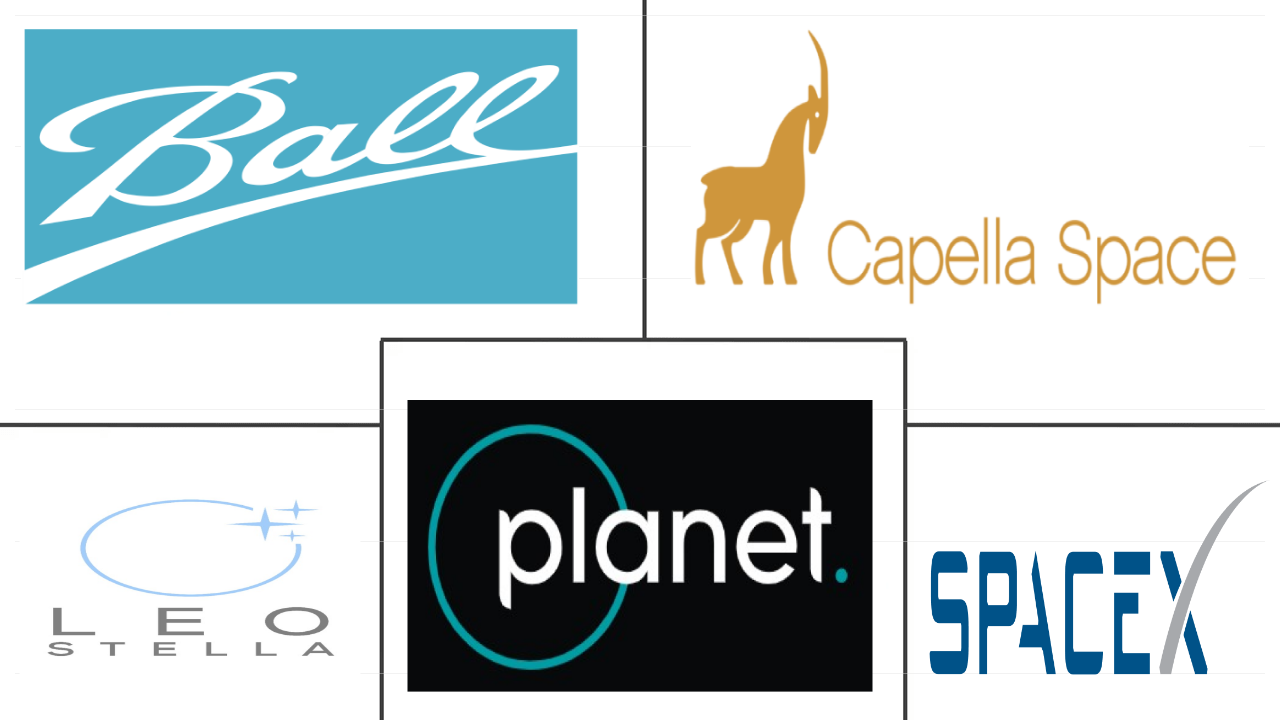Market Size of north america small satellite Industry

|
|
Study Period | 2017 - 2029 |
|
|
Market Size (2024) | USD 147.25 Billion |
|
|
Market Size (2029) | USD 222.08 Billion |
|
|
Largest Share by Orbit Class | LEO |
|
|
CAGR (2024 - 2029) | 8.57 % |
|
|
Largest Share by Country | United States |
Major Players |
||

|
||
|
*Disclaimer: Major Players sorted in no particular order |
North America Small Satellite Market Analysis
The North America Small Satellite Market size is estimated at USD 147.25 billion in 2024, and is expected to reach USD 222.08 billion by 2029, growing at a CAGR of 8.57% during the forecast period (2024-2029).
147.25 Billion
Market Size in 2024 (USD)
222.08 Billion
Market Size in 2029 (USD)
146.61 %
CAGR (2017-2023)
8.57 %
CAGR (2024-2029)
Largest Market by Satellite Subsystem
25 %
value share, Solar Array & Power Hardware, 2022
The demand for these propulsion systems is driven by the launch of mass satellite constellations into space. They are used for transferring the spacecraft into orbit.
Largest Market by Application
95.62 %
value share, Communication, 2022
Governments, space agencies, defense agencies, private defense contractors, and private space industry players are emphasizing the enhancement of the communication network capabilities for various public and military reconnaissance applications.
Largest Market by Orbit Class
99.74 %
value share, LEO, 2022
LEO satellites are increasingly being adopted in modern communication technologies as they play an important role in Earth observation applications.
Leading Market Player
99.15 %
market share, Space Exploration Technologies Corp, 2022

SpaceX is the leading player in the global satellite manufacturing market and maintains its market share globally through its Starlink project in over 53 countries. The company produces 120 satellites per month.
Second Leading Market Player
0.17 %
market share, Capella Space Corp., 2022

Capella Space is the second-leading company in the market. It is developing space-based radar Earth observation satellites equipped with synthetic-aperture radar that can penetrate clouds and work at night.
LEO satellites are driving the demand for small satellites
- During launch, a satellite or spacecraft is usually placed into one of many special orbits around the Earth, or it can be launched into an interplanetary journey. There are three types of Earth orbits, namely, geostationary orbit (GEO), medium Earth orbit, and low Earth orbit. Many weather and communication satellites tend to have high Earth orbits farthest from the surface. Satellites in medium Earth orbit include navigational and specialized satellites designed to monitor a specific area. Most science satellites, including NASA's Earth Observation System, are in low Earth orbit.
- The small satellite market is experiencing strong growth, driven by the increasing demand for LEO satellites, which are used for communication, navigation, Earth observation, military reconnaissance, and scientific missions. Between 2017 and 2022, around 2,900 small LEO satellites were manufactured and launched in North America alone, primarily for communication purposes. This has led companies such as SpaceX, OneWeb, and Amazon to plan the launch of thousands of satellites into LEO. With the rising demand for low Earth orbit from various sectors like Earth observation, navigation, meteorology, and military communications, the region has witnessed an increase in the number of LEO satellite launches.
- The military's use of MEO and GEO satellites has grown in recent years due to their advantages, including increased signal strength, improved communications and data transfer capabilities, and greater coverage area. For instance, Raytheon Technologies’ and Boeing's Millennium Space Systems are developing the first prototype Missile Track Custody (MTC) MEO OPIR payloads to detect and track hypersonic missiles for the US Space Force.
North America Small Satellite Industry Segmentation
Communication, Earth Observation, Navigation, Space Observation, Others are covered as segments by Application. GEO, LEO, MEO are covered as segments by Orbit Class. Commercial, Military & Government are covered as segments by End User. Electric, Gas based, Liquid Fuel are covered as segments by Propulsion Tech.
- During launch, a satellite or spacecraft is usually placed into one of many special orbits around the Earth, or it can be launched into an interplanetary journey. There are three types of Earth orbits, namely, geostationary orbit (GEO), medium Earth orbit, and low Earth orbit. Many weather and communication satellites tend to have high Earth orbits farthest from the surface. Satellites in medium Earth orbit include navigational and specialized satellites designed to monitor a specific area. Most science satellites, including NASA's Earth Observation System, are in low Earth orbit.
- The small satellite market is experiencing strong growth, driven by the increasing demand for LEO satellites, which are used for communication, navigation, Earth observation, military reconnaissance, and scientific missions. Between 2017 and 2022, around 2,900 small LEO satellites were manufactured and launched in North America alone, primarily for communication purposes. This has led companies such as SpaceX, OneWeb, and Amazon to plan the launch of thousands of satellites into LEO. With the rising demand for low Earth orbit from various sectors like Earth observation, navigation, meteorology, and military communications, the region has witnessed an increase in the number of LEO satellite launches.
- The military's use of MEO and GEO satellites has grown in recent years due to their advantages, including increased signal strength, improved communications and data transfer capabilities, and greater coverage area. For instance, Raytheon Technologies’ and Boeing's Millennium Space Systems are developing the first prototype Missile Track Custody (MTC) MEO OPIR payloads to detect and track hypersonic missiles for the US Space Force.
| Application | |
| Communication | |
| Earth Observation | |
| Navigation | |
| Space Observation | |
| Others |
| Orbit Class | |
| GEO | |
| LEO | |
| MEO |
| End User | |
| Commercial | |
| Military & Government | |
| Other |
| Propulsion Tech | |
| Electric | |
| Gas based | |
| Liquid Fuel |
North America Small Satellite Market Size Summary
The North America small satellite market is experiencing robust growth, driven by the increasing demand for low Earth orbit (LEO) satellites used in various applications such as communication, navigation, Earth observation, military reconnaissance, and scientific missions. The region has seen a significant number of LEO satellite launches, with major companies like SpaceX, OneWeb, and Amazon planning to deploy thousands of satellites. The military's reliance on medium Earth orbit (MEO) and geostationary orbit (GEO) satellites has also grown, benefiting from enhanced signal strength and coverage. The trend towards smaller satellites is gaining momentum due to their cost-effectiveness and shorter development cycles, making them a viable alternative to conventional satellites. This shift is supported by technological advancements in miniaturization and smart materials, which have reduced satellite size and mass, enabling more flexible and responsive missions.
The small satellite industry in North America is bolstered by a strong framework for designing and manufacturing satellites tailored to specific applications. The region's government expenditure on space programs is substantial, with the United States leading globally in satellite development and launches. The presence of NASA and other key players underscores North America's role as a hub for space innovation. The market is fairly consolidated, with major companies like Ball Corporation, Capella Space Corp., LeoStella, Planet Labs Inc., and Space Exploration Technologies Corp dominating the landscape. These companies are actively expanding their satellite constellations to meet the growing demands in commercial and military sectors, further driving the market's expansion.
North America Small Satellite Market Size - Table of Contents
-
1. MARKET SEGMENTATION (includes market size in Value in USD, Forecasts up to 2029 and analysis of growth prospects)
-
1.1 Application
-
1.1.1 Communication
-
1.1.2 Earth Observation
-
1.1.3 Navigation
-
1.1.4 Space Observation
-
1.1.5 Others
-
-
1.2 Orbit Class
-
1.2.1 GEO
-
1.2.2 LEO
-
1.2.3 MEO
-
-
1.3 End User
-
1.3.1 Commercial
-
1.3.2 Military & Government
-
1.3.3 Other
-
-
1.4 Propulsion Tech
-
1.4.1 Electric
-
1.4.2 Gas based
-
1.4.3 Liquid Fuel
-
-
North America Small Satellite Market Size FAQs
How big is the North America Small Satellite Market?
The North America Small Satellite Market size is expected to reach USD 147.25 billion in 2024 and grow at a CAGR of 8.57% to reach USD 222.08 billion by 2029.
What is the current North America Small Satellite Market size?
In 2024, the North America Small Satellite Market size is expected to reach USD 147.25 billion.

